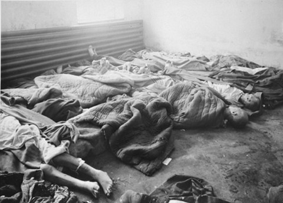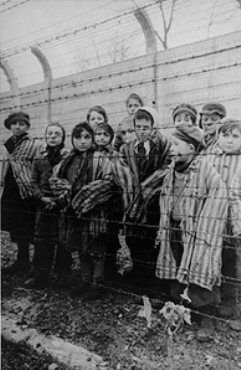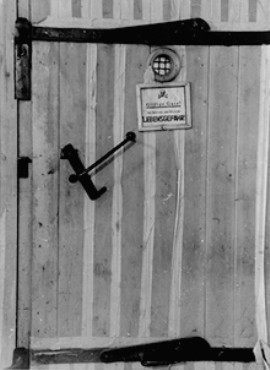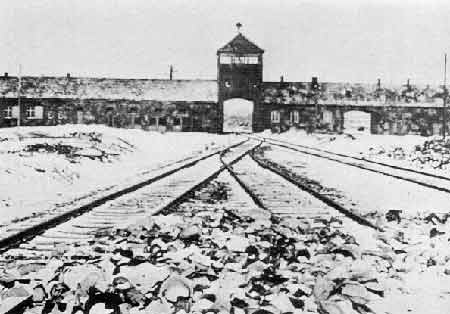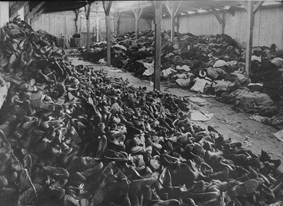Auschwitz-Birkenau: History & Overview
Introduction
Establishing the Camp
Expanding Auschwitz
Beginning Stages of the Final Solution
Camp Reorganization & Worsening Conditions
Birkenau Becomes Center of Jewish Extermination
Resistance
Death March & Allied Liberation
Auschwitz Today
Introduction
Auschwitz-Birkenau is the general term for the network of Nazi concentration and labor camps established near the Polish city of Oswiecim. Together this complex was the largest of all the Nazi death camps across Europe and could hold upwards of 150,000 inmates at any given time.
The complex, which was divided into three main areas, was established by the Nazis in 1940 and was in use until its Allied liberation in 1945. Historians and analysts estimate the number of people murdered at Auschwitz somewhere between 2.1 million to 4 million, of whom the vast majority were Jews. Most prisoners held at Auschwitz were killed in gas chambers, though many died from starvation, forced labor, disease, shooting squads, and heinous medical experiments.
Establishing the Camp
In April 1940, Rudolph Höss, who became the first commandant of Auschwitz, identified the Silesian town of Oswiecim in Poland as a possible site for a concentration camp. Initially, the camp was meant to intimidate Poles to prevent them from protesting German rule and to serve as a prison for those who did resist. It was also perceived as a cornerstone of the policy to re-colonize Upper Silesia, which had once been a German region, with “pure Aryans.” When the plans for the camp were approved, the Nazis changed the name of the area to Auschwitz.
On April 27, 1940, Heinrich Himmler ordered construction of the camp.
In May 1940, Poles were evicted from the vicinity of the barracks (most of them were executed), and a work crew comprising concentration camp prisoners was sent from Sachsenhausen. Another 300 Jews from the large Jewish community of Oswiecim were also pressed into service.
On May 20, 1940, the first transport of prisoners, almost all Polish civilians, arrived, and the SS administration and staff were established. On March 1, 1941, the camp population was 10,900. Quickly, the camp developed a reputation for torture and mass shootings.
|
|
Expansion of Auschwitz
In March 1941, Himmler visited Auschwitz and commanded its enlargement to hold 30,000 prisoners. The location of the camp, practically in the center of German-occupied Europe, and its convenient transportation connections and proximity to rail lines were the main thinking behind the Nazi plan to enlarge Auschwitz and begin deporting people here from all over Europe.
At this time, only the main camp, later known as Auschwitz I, had been established. Himmler ordered the construction of a second camp for 100,000 inmates on the site of the village of Brzezinka, roughly two miles from the main camp. This second camp, now known as Birkenau or Auschwitz II, was initially intended to be filled with captured Russian POWs who would provide slave labor to build the SS “utopia” in Upper Silesia. Chemical giant I G Farben expressed an interest in utilizing this labor force, and extensive construction work began in October 1941 under terrible conditions and with massive loss of life. About 10,000 Russian POWs died in this process. The greater part of the apparatus of mass extermination was eventually built in the Birkenau camp, and most of the victims were murdered there.
SS-Sturmbannfuhrer Fritz Hartjenstein was commandant of Birkenau from November 22, 1943, until May 8, 1944. He was followed by SS-Hauptsturmfuhrer Josef Kramer from May 8, 1944, until November 25, 1944.
More than 40 sub-camps, exploiting the prisoners as slave laborers, were also founded, mainly as various sorts of German industrial plants and farms, between 1942 and 1944. The largest of them was called Buna (Monowitz, with ten thousand prisoners) and was opened by the camp administration in 1942 on the grounds of the Buna-Werke synthetic rubber and fuel plant, about four miles (six km) from the Auschwitz camp. The factory was built during the war by the German IG Farbenindustrie cartel, and the SS supplied prisoner labor. On November 1943, the Buna sub-camp became the seat of the commandant (SS-Hauptsturmfuhrer Heinrich Schwarz) of the third part of the camp, Auschwitz III, to which some other Auschwitz sub-camps were subordinated.
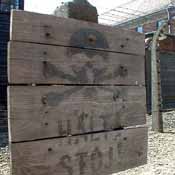
The Germans isolated all the camps and sub-camps from the outside world and surrounded them with barbed wire fencing. All contact with the outside world was forbidden. However, the area administered by the commandant and patrolled by the SS camp garrison went beyond the grounds enclosed by barbed wire. It included an additional area of approximately 40 square kilometers (the so-called “Interessengebiet” - the interest zone), which lay around the Auschwitz I and Auschwitz II-Birkenau camps.
With the additions, the main camp population grew from 18,000 in December 1942 to more than 30,000 in March 1943.
In March 1942, a women’s camp was established at Auschwitz with 6,000 inmates, and in August, it was moved to Birkenau. By January 1944, 27,000 women were living in Birkenau, in section B1a, in separate quarters.
In February 1943, a section for Gypsies was also established at Birkenau, called camp BIIe, and in September 1943, an area was set aside for Czech Jews deported from Theresienstadt, and was so-called the “Family Camp,” or BIIb.
The gas chambers and crematoria at Birkenau were opened in March 1943.
Beginning Stages of the Final Solution

Beginning in 1942, Auschwitz began to function in a way different than its original intent.
By late 1941, Himmler had briefed Commandant Höss about the “Final Solution“ and by the following year Auschwitz-Birkenau became the center of the mass destruction of the European Jews.
Before beginning Jewish exterminations, though, the Nazis used the Soviet POWs at the Auschwitz camp in trials of the poison gas Zyklon-B, produced by the German company “Degesch” (Deutsche Gesellschaft zur Schädlingsbekämpfung), which was marked as the best way to kill many people at once. The POWs were gassed in underground cells in Block 11, the so-called “Death Block,” and following these trials, one gas chamber was set up just outside the main camp, and two temporary gas chambers were opened at Birkenau.
The Nazis marked all the Jews living in Europe for total extermination, regardless of their age, sex, occupation, citizenship, or political views. They were killed for one reason, and one reason alone – because they were Jews. At Auschwitz-Birkenau, the “Final Solution“ was pursued with Nazi-like efficiency:
|
|
When a train carrying Jewish prisoners arrived “selections” would be conducted on the railroad platform, or ramp. Newly arrived persons classified by the SS physicians as unfit for labor were sent to the gas chambers: these included the ill, the elderly, pregnant women and children. In most cases, 70-75% of each transport was sent to immediate death. These people were not entered in the camp records; that is, they received no serial numbers and were not registered, and therefore it is possible only to estimate the total number of victims.
Those deemed fit enough for slave labor were then immediately registered, tattooed with a serial number, undressed, deloused, had their body hair shaven off, showered while their clothes were disinfected with Zyklon-B gas, and entered the camp under the infamous gateway inscribed “Arbeit Macht Frei” (“Labor will set you free”). Of approximately 2.5 million people who were deported to Auschwitz, 405,000 were given prisoner status and serial numbers. Of these, approximately 50% were Jews, and 50% were Poles and other nationalities.
Camp Reorganization & Worsening Conditions
In the Autumn of 1943, the camp administration was reorganized following a corruption scandal. Höss, who served as commandant from May 4, 1940, until November 10, 1943, was succeeded by SS-Obersturmbannfuhrer Arthur Liebehenschel. The third commandant, SS-Sturmbannfuhrer Richard Baer took over from May 11, 1944, until January 1945.
By the end of 1943, the prisoner population of Auschwitz's main camp, Birkenau, Monowitz, and other subcamps was over 80,000: 18,437 in the main camp, 49,114 in Birkenau, and 13,288 at Monowitz, where I G Farben had its synthetic rubber plant. Up to 50,000 prisoners were scattered around 51 subcamps, such as Rajsko, an experimental agricultural station, and Gleiwitz, a coal mine (see The List of the Camps for a complete list of those subcamps). Barracks at Auschwitz designed for 700 prisoners held 1,200.
The situation in the subcamps was often even worse than in the main camps. In mid-1944, Auschwitz was designated an SS-run security area of over 40 square miles. By August 1944, the camp population reached 105,168. The last roll-call on January 18th, 1945, showed 64,000 inmates.
During its history, the prison population of Auschwitz changed composition significantly. At first, its inmates were almost entirely Polish. From April 1940 to March 1942, of about 27,000 inmates, 30 percent were Poles, and 57 percent were Jews. From March 1942 to March 1943, of 162,000 inmates, 60 percent were Jews. From May 15 to July 9, 1944, 426,000 Hungarian Jews, the most deported from any country, were sent to Auschwitz
Birkenau Becomes Center of Jewish Extermination
|
|
A parallel system to the main camp in Auschwitz began to operate at the Birkenau camp by 1942. The exception, though, was that most “showers” used to delouse the incoming prisoners proved to be gas chambers. At Birkenau, only about 10 percent of Jewish transports were registered, disinfected, shaven, and showered in the “central sauna” before being assigned barracks as opposed to being sent directly to the death chambers.
In the spring of 1942, two provisional gas chambers at Birkenau were constructed out of peasant huts, known as the “bunkers.”
The first “bunker,” with two sealed rooms, operated from January 1942 to the end of that year. The second, with four airtight rooms, became redundant in the spring of 1943, but remained standing and was used again in the autumn of 1944 when extra “capacity” was needed for the murder of Hungarian Jews and the liquidation of the ghettos. The second measured about 1.134 square feet. The victims murdered in the “bunkers” were first obliged to undress in temporary wooden barracks erected nearby. Their bodies were taken out of the gas chambers and pushed to pits where they were burned in the open.
Between January 1942 and March 1943, 175,000 Jews were gassed to death here, of whom 105,000 were killed from January to March 1943.
Up to this point, though, Auschwitz-Birkenau accounted for “only” 11 percent of the victims of the “Final Solution.” In August 1942, however, construction began on four large-scale gassing facilities. It appears from the plans that the first two gas chambers were adapted from mortuaries which, with the huge crematoria attached to them, were initially intended to cope with mortalities amongst the slave labor force in the camp, now approaching 100,000 and subject to a horrifying death rate. But from the autumn of 1942, it seems clear that the SS planners and civilian contractors were intending to build a mass-murder plant.
|
|
The twin pairs of gas chambers were numbered II and III, and IV and V. The first opened on March 31, 1943, and the last on April 4, 1943. The total area of the gas chambers was 2,255 square meters; the capacity of these crematoria was 4,420 people. Those selected to die were undressed in the undressing room and then pushed into the gas chambers.
It only took about 20 minutes for all the people inside to die.
In chambers II and III, the killings took place in underground rooms, and the corpses were carried to the five ovens by an electrically operated lift. Before cremation, gold teeth and any other valuables, such as rings, were removed from the corpses. In IV and V, the gas chambers and ovens were on the same level, but the ovens were so poorly built, and the usage was so great that they repeatedly malfunctioned and had to be abandoned. The corpses were finally burned outside, in the open, as in 1943. Jewish Sonderkommandos worked the crematoria under SS supervision.
Initially, the new facilities were “underutilized.” From April 1943 to March 1944, “only” 160,000 Jews were killed at Birkenau.
But, in May 1944, a railroad spur line was built right into the camp to accelerate and simplify the handling of the tens of thousands of Hungarian and other Jews deported in the spring and summer of 1944. From then to November 1944, when all the other death camps had been abandoned, Birkenau surpassed all previous records for mass killing. The Hungarian deportations and the liquidation of the remaining Polish ghettos, such as Lodz, resulted in the gassing of 585,000 Jews. This period made Auschwitz-Birkenau the most notorious killing site of all time.
|
|
Resistance
Remarkably, there were instances of individual resistance and collective efforts to fight back inside Auschwitz. Poles, Communists, and other national groups established networks in the main camp. Some Jews assaulted Nazi guards, even at the entrance to the gas chambers. In October 1944, the Sonderkommando crew at Crematoria IV revolted and destroyed the crematoria. It was never used again.
As the United States Holocaust Memorial Museum noted, “Escape from Auschwitz was almost impossible. Electrically charged barbed-wire fences surrounded both the concentration camp and the killing center. Guards, equipped with machine guns and automatic rifles, stood in the many watchtowers.”
Fewer than 200 Jews escaped from the camps. Herman Shine, one of the last survivors to have escaped Auschwitz, died in July 2018. He was born in Berlin to a Polish father, and they were arrested in that city in 1939. Along with 1,700 other Polish Jews, they were deported to Sachsenhausen. To survive, Shine claimed to be a roofer and learned how to build roofs before being transferred to Auschwitz in 1942.
While working at an Auschwitz satellite forced labor camp in Gleiwitz, Shine met a Jewish girl named Marianne who worked in the camp and could return to her home at night.
Another prisoner, Max Drimmer, devised an escape plan and brought it to Shine. Thanks to the help of a Polish partisan, they managed to break out of Auschwitz and hide on the Pole’s farm for three months. Later, they hid in the home of Marianne’s family. Both men immigrated to the United States, and Shine married Marianne. Their story was told in the documentary, “Escape from Auschwitz: Portrait of a Friendship.”
On June 20, 1942, Kazimierz Piechowski, Eugeniusz Bendera, Józef Lempart, and Stanislaw Gustaw Jaster stole SS uniforms and a vehicle that allowed them to make a daring escape.
Death March & Allied Liberation
In November of 1944, in the face of the approaching allied Red Army, Himmler ordered gassings to stop and for a “clean-up” operation to be put in place to conceal traces of the mass murder and other crimes that they had committed. The Nazis destroyed documents and dismantled, burned down, or blew up most buildings.
The orders for the final evacuation and liquidation of the camp were issued in mid-January 1945. The Germans left behind in the main Auschwitz camp, Birkenau, and Monowitz, about 7,000 sick or incapacitated who they did not expect would live for long; the rest, approximately 58,000 people, were evacuated by foot into the depths of the Third Reich.
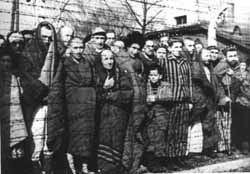
Able-bodied prisoners began forcibly marching just as Soviet soldiers were liberating Cracow, some 40 miles (60 km) from the camp. In marching columns escorted by heavily armed SS guards, these 58,000 men and women prisoners were led out of Auschwitz from January 17-21. Many prisoners lost their lives during this tragic evacuation, known as the Death March.
Lt.-Col. Anatoly Shapiro, a Ukrainian Jew, commanded the Red Army’s 1085th ‘Tarnopol’ Rifle Regiment that liberated Auschwitz on January 27, 1945. The soldiers found about 650 corpses inside the barracks and near them — mostly women who died of exhaustion or were shot by the SS the night before. Altogether, the Soviet troops found at least 1,200 emaciated survivors in Auschwitz and another 5,800 at Birkenau. At least 700 children and youth prisoners, including about 500 under 15, were alive when the Soviet soldiers arrived. More than half of these children were Jewish.
The liberators fed the survivors, but most could not eat because they were too malnourished. Ultimately, another soldier said the Red Army managed to save 2,819 inmates in Red Army Military Hospital 2962.
The soldiers also found warehouses containing 836,525 items of women's clothing, 348,820 items of men's clothing, 43,525 pairs of shoes (a total of 110,000 was ultimately discovered), and vast numbers of toothbrushes, glasses, and other personal effects. They also found 460 artificial limbs and seven tons of human hair shaved from Jews before they were murdered. The human hairs were used by the company “Alex Zink” (located in Bavaria) for confection of cloth. This company was paying the Nazis 50 pfennig per kilo of human hair.
Of the 1.3 million people sent to Auschwitz-Birkenau, nearly 1,095,000 were Jews, including 232,000 children (mostly Jews). A total of 1.1 million prisoners, or about 85 percent of people sent to Auschwitz, were murdered in the camp, including 960,000 Jews, 74,000 non-Jewish Poles, 21,000 Roma, and 15,000 Soviet prisoners of war.
Of those who received numbers at Auschwitz-Birkenau, only 65,000 survived. It is estimated that only about 200,000 people who passed through the Auschwitz camps survived. Michael Bornstein was one of the lucky ones. Decades after the war, he learned from Auschwitz documents kept in Israel that he had survived because he was sick, and the Nazis left him behind when they evacuated the camp. He said that he was one of only 52 children under the age of eight who lived.
A total of 673 members of the camp staff were charged with war crimes.
Auschwitz Today
Today, the word Auschwitz has become synonymous with terror, genocide, and the Holocaust. The site, though partially destroyed by the retreating Nazis in 1945, has been established as a museum to help future generations understand the atrocities committed within its fences. Millions of people have visited the Auschwitz complex and museum, including a record 2.3 million in 2019.
In June 2016, the Auschwitz-Birkenau museum in the Polish town of Oswiecim discovered over 16,000 personal items belonging to victims of Auschwitz-Birkenau that had been lost in 1968. The items were originally discovered in 1967 by archaeologists excavating the concentration camp site and were placed in 48 cardboard boxes in the Polish Academy of Sciences in Warsaw before being lost due to an anti-Semitic communist regime coming to power in 1968.
Sources: The Forgotten Camps.
Memorial and Museum of Auschwitz-Birkenau.
Haaretz, (April 22, 2015).
Agencja Gazeta, “Auschwitz museum recovers thousands of long-lost items after 50 years,” Reuters (June 8, 2016).
Michael Scotto, After Seeing Himself in Old Newsreel Footage, Manhattan Man Discovers How He Survived Holocaust,
Spectrum News, (April 3, 2017).
“Auschwitz hero,” Jerusalem Report, (February 5, 2018).
“Herman Shine, one of the last survivors to have escaped Auschwitz, dies at 96,” JTA, (July 24, 2018).
Natasha Frost, “Horrors of Auschwitz: The Numbers Behind WWII's Deadliest Concentration Camp,” History, (January 23, 2020).
“Auschwitz,” Holocaust Encyclopedia, United States Holocaust Memorial Museum.
“Auschwitz Camp Complex,” Holocaust Encyclopedia, United States Holocaust Memorial Museum.
